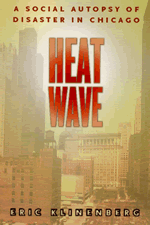As temps rise in NY, remember the great Chicago heat wave

As the temperature tops 100 degrees on the east coast many, especially in major urban centers, are bracing for the consequences. As history has shown, these consequences can include power failures, hospitalizations, and even deaths. Case in point: Chicago, 1995, when one of the most disastrous heat waves ever to strike the US killed over seven hundred people who succumbed to a week-long onslaught of 90-to-100 degree temperatures.
Eric Klinenberg’s Heat Wave: A Social Autopsy of Disaster in Chicago documents this tragedy and attempts to answer the question of how, in a day and age where the simplest of technologies could have avoided such disaster, so many could have perished. Revealing the tragedy’s darker social dimension, Klinenberg shows how a number of surprising and unsettling forms of social breakdown—including the literal and social isolation of seniors, the institutional abandonment of poor neighborhoods, and the retrenchment of public assistance programs—contributed to the high fatality rates.
As Klinenberg demonstrates in this incisive account of the contemporary urban condition, the widening cracks in the social foundations of American cities that the 1995 Chicago heat wave made visible have by no means subsided as the temperatures returned to normal. The forces that affected Chicago so disastrously remain in play in America’s cities, and we ignore them at our peril.
Read an interview with the author.